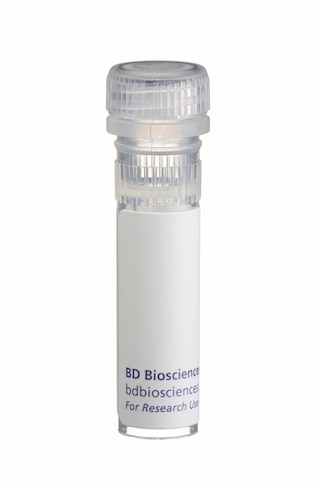Old Browser
This page has been recently translated and is available in French now.
Looks like you're visiting us from {countryName}.
Would you like to stay on the current country site or be switched to your country?


.png)

Flow cytometric analysis of CD210 expression on mouse B220+ splenocytes. Mouse splenocytes were stained with FITC Rat Anti-Mouse CD45R/B220 (Cat. No. 553088) and either PE Rat IgG1, κ Isotype Control (Cat. No. 554685; empty histograms) or PE Rat Anti-Mouse CD210 (Cat. No. 559914; filled histograms) at 0.25 µg/test. Mouse splenocytes were preincubated on ice with recombinant mouse IL-10 (0.25 µg, Cat. No. 550070) prior to staining with PE Rat Anti-Mouse CD210 (Right Panel) to determine the blocking effect of bound IL-10 protein on staining with conjugated antibody. Fluorescence histograms depicting CD210 (or Ig isotype control) expression were derived from gated events with the side and forward light-scattering characteristics of viable B220+ lymphocytes.
.png)

APO-BRDU™ PE Rat Anti-Mouse CD210
.png)
Regulatory Status Legend
Any use of products other than the permitted use without the express written authorization of Becton, Dickinson and Company is strictly prohibited.
Preparation And Storage
Recommended Assay Procedures
Immunofluorescent staining and flow cytometric analysis: PE Rat Anti-Mouse CD210 antibody (Cat. No. 559914) can be used for immmunofluorescent staining (≤ 1 µg antibody/10×6 cells) and flow cytometric analysis of the levels of membrane IL-10R expressed by mouse cell lines or mouse leukocytes. An appropriate R-PE-conjugated immunoglobulin isotype-matched control is PE Rat IgG1, κ Isotype Control (Cat. No. 554685).
Note: Since 1B1.3a is a neutralizing antibody, it competes with IL-10 for binding to its receptor. Therefore, the use of the 1B1.3a antibody for immunofluorescent staining and flow cytometric analysis in systems where the natural ligand of the receptor is present may give an underestimation of IL-10R expression. Based on our historical testing results, the presence of recombinant mouse IL-10 protein at levels above 250 ng/ml is sufficient to partially inhibit the binding of the 1B1.3a antibody (at 0.12 µg/10e6 cells).
BD™ CompBeads can be used as surrogates to assess fluorescence spillover (Compensation). When fluorochrome conjugated antibodies are bound to CompBeads, they have spectral properties very similar to cells. However, for some fluorochromes there can be small differences in spectral emissions compared to cells, resulting in spillover values that differ when compared to biological controls. It is strongly recommended that when using a reagent for the first time, users compare the spillover on cell and CompBead to ensure that BD Comp beads are appropriate for your specific cellular application.
In vitro neutralization: Purified NA/LE Rat Anti-Mouse CD210 antibody (Cat. No. 550012) is useful for bioassay.
Product Notices
- Since applications vary, each investigator should titrate the reagent to obtain optimal results.
- An isotype control should be used at the same concentration as the antibody of interest.
- Caution: Sodium azide yields highly toxic hydrazoic acid under acidic conditions. Dilute azide compounds in running water before discarding to avoid accumulation of potentially explosive deposits in plumbing.
- For fluorochrome spectra and suitable instrument settings, please refer to our Multicolor Flow Cytometry web page at www.bdbiosciences.com/colors.
- Please refer to http://regdocs.bd.com to access safety data sheets (SDS).
- Please refer to www.bdbiosciences.com/us/s/resources for technical protocols.
Companion Products
.png?imwidth=320)


The 1B1.3a antibody reacts with the extracellular region of mouse CD210 which is also known as the mouse IL-10 receptor (mIL-10R); it does not recognize the human IL-10R. The IL-10R is expressed by a variety of mouse cell types and cell lines including thymocytes, T cells, B cells, and monocytes. 1B1.3a is a neutralizing antibody and reportedly blocks the binding of human IL-10, which cross-reacts with the mouse IL-10R. The immunogen used for the generation of the 1B1.3a hybridoma was purified recombinant ligand-binding domain of mIL-10R.

Development References (1)
-
O'Farrell AM, Liu Y, Moore KW, Mui AL. IL-10 inhibits macrophage activation and proliferation by distinct signaling mechanisms: evidence for Stat3-dependent and -independent pathways. EMBO J. 1998; 17(4):1006-1018. (Immunogen: Neutralization). View Reference
Please refer to Support Documents for Quality Certificates
Global - Refer to manufacturer's instructions for use and related User Manuals and Technical data sheets before using this products as described
Comparisons, where applicable, are made against older BD Technology, manual methods or are general performance claims. Comparisons are not made against non-BD technologies, unless otherwise noted.
For Research Use Only. Not for use in diagnostic or therapeutic procedures.
Report a Site Issue
This form is intended to help us improve our website experience. For other support, please visit our Contact Us page.